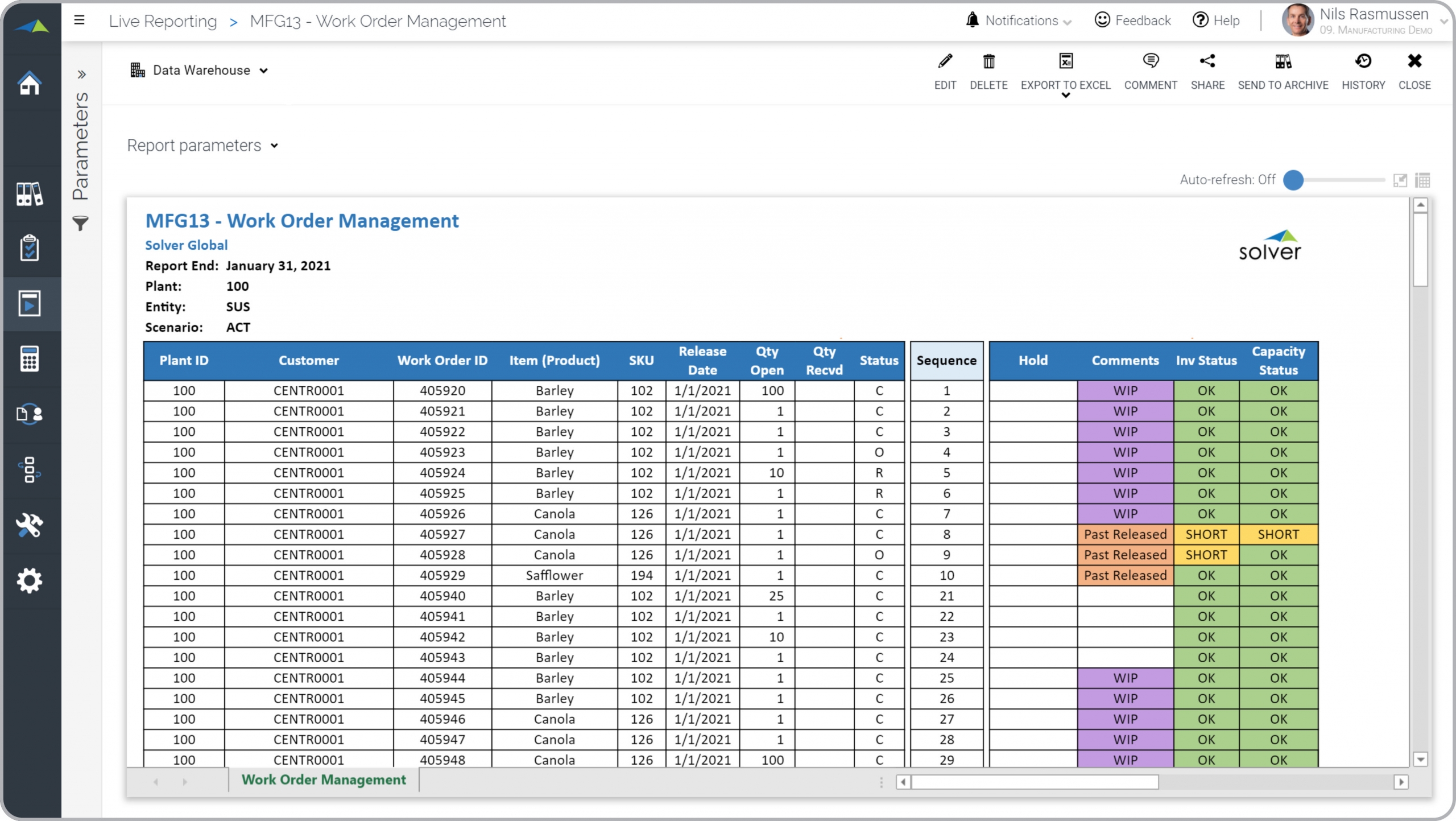Work Order Management Report for Manufacturing Plants
What is
a
Work Order Management Report for Manufacturing Plants
? Work Order Management reports are considered essential production planning reports and are often used by production managers to determine the priority and sequence of the products they manufacture. Key functionality in this type of report shows work orders by plant, customer and item. It also displays production sequence, inventory and capacity statuses. You will find an example of this type of report below.
Purpose of
Work Order Management Reports Manufacturing plants use Work Order Management Reports to manage manufacturing priorities. When used as part of good business practices in a Production department, a company can improve its ability to meet customer orders in a timely manner, as well as, reduce the chances that line managers don't see an upcoming issue related to inventory shortage or manufacturing capacity.
Work Order Management Report
Example Here is an example of detailed Work Order Management report. [caption id="" align="alignnone" width="2560"]
 Work Order Management Report for Manufacturing Plants Example[/caption] You can find hundreds of additional examples
here.
Who Uses This Type of
Report
? The typical users of this type of report are: Production and Fulfillment Managers.
Other
Report
s Often Used in Conjunction with
Work Order Management Reports Progressive Production Departments sometimes use several different Work Order Management Reports, along with production dashboards, inventory reports, sales forecast, sales reports and other management and control tools.
Where Does the Data for Analysis Originate From? The Actual (historical transactions) data typically comes from enterprise resource planning (ERP) systems like: Microsoft Dynamics 365 (D365) Finance, Microsoft Dynamics 365 Business Central (D365 BC), Microsoft Dynamics AX, Microsoft Dynamics NAV, Microsoft Dynamics GP, Microsoft Dynamics SL, Sage Intacct, Sage 100, Sage 300, Sage 500, Sage X3, SAP Business One, SAP ByDesign, Acumatica, Netsuite and others. In analyses where budgets or forecasts are used, the planning data most often originates from in-house Excel spreadsheet models or from professional corporate performance management (CPM/EPM) solutions.
What Tools are Typically used for Reporting, Planning and Dashboards? Examples of business software used with the data and ERPs mentioned above are:
Work Order Management Report for Manufacturing Plants Example[/caption] You can find hundreds of additional examples
here.
Who Uses This Type of
Report
? The typical users of this type of report are: Production and Fulfillment Managers.
Other
Report
s Often Used in Conjunction with
Work Order Management Reports Progressive Production Departments sometimes use several different Work Order Management Reports, along with production dashboards, inventory reports, sales forecast, sales reports and other management and control tools.
Where Does the Data for Analysis Originate From? The Actual (historical transactions) data typically comes from enterprise resource planning (ERP) systems like: Microsoft Dynamics 365 (D365) Finance, Microsoft Dynamics 365 Business Central (D365 BC), Microsoft Dynamics AX, Microsoft Dynamics NAV, Microsoft Dynamics GP, Microsoft Dynamics SL, Sage Intacct, Sage 100, Sage 300, Sage 500, Sage X3, SAP Business One, SAP ByDesign, Acumatica, Netsuite and others. In analyses where budgets or forecasts are used, the planning data most often originates from in-house Excel spreadsheet models or from professional corporate performance management (CPM/EPM) solutions.
What Tools are Typically used for Reporting, Planning and Dashboards? Examples of business software used with the data and ERPs mentioned above are:
- Native ERP report writers and query tools
- Spreadsheets (for example Microsoft Excel)
- Corporate Performance Management (CPM) tools (for example Solver)
- Dashboards (for example Microsoft Power BI and Tableau)
Corporate Performance Management (CPM) Cloud Solutions and More Examples
Learn More About Solver CPM For Manufacturing
September 24, 2020
TAGS:
Reporting,
Solver,
plant,
report writer,
Microsoft,
consolidation,
manufacturing,
template,
practice,
Acumatica,
customer,
Netsuite,
Finance,
GP,
status,
Inventory,
Business Central,
capacity,
excel,
quantity,
item,
ax,
forecast,
Budget,
forecasting,
budgeting,
Cloud,
Software,
production,
Tableau,
SAP,
example,
best,
Sage,
BC,
D365,
NAV,
Intacct,
facility,
sku,
CPM,
report,
SL,
Management,
dynamics,
Power BI

